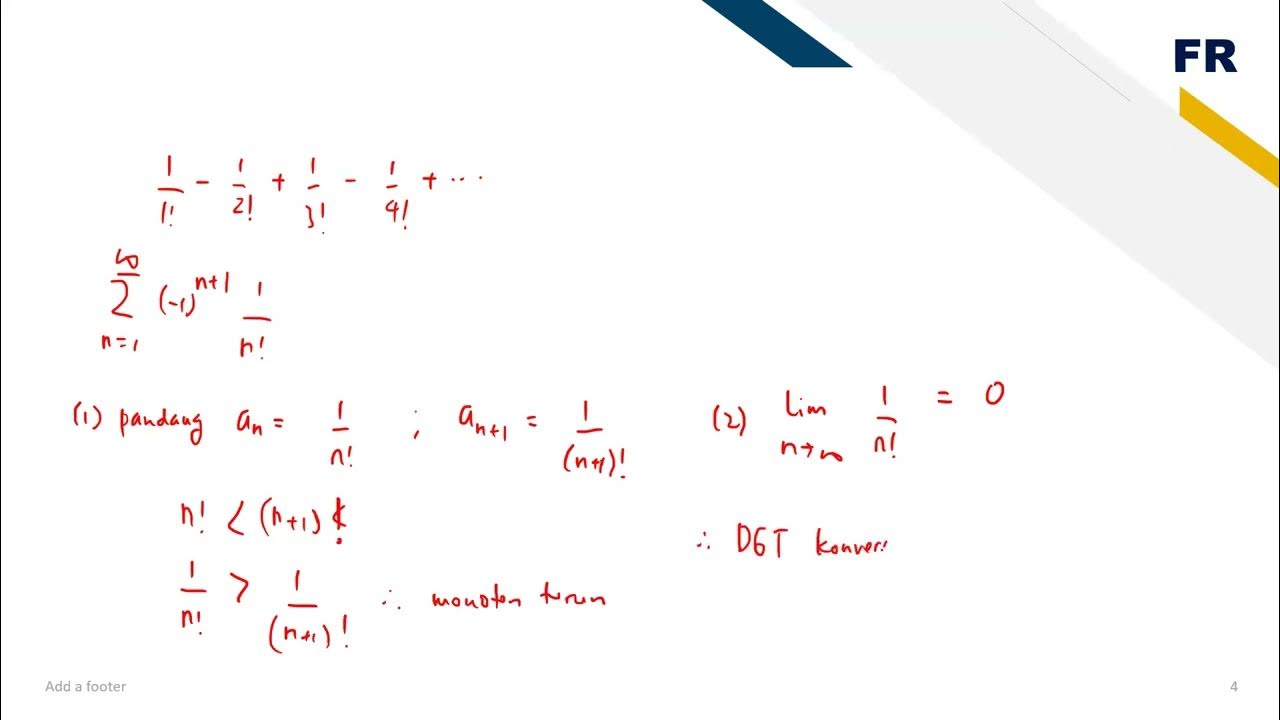[Math 22] Lec 08 Integral Test and Comparison Test (Part 1 of 2)
Summary
TLDRThis lecture video focuses on series convergence tests, particularly for series of non-negative terms. It begins by introducing the concept of convergence and divergence in series, then discusses various tests, including the integral test. Examples are provided, such as the series of 2n/(1+n^2) and others involving sine and cosine functions. The video also explores the p-series test, detailing conditions for series convergence or divergence based on the value of p. The instructor emphasizes applying integral tests and concludes with solving practical problems to determine series behavior.
Takeaways
- 📚 In the previous lecture, we learned about a series test which determines whether a series is divergent, but it cannot show convergence.
- 🔍 Today's focus is on convergence tests, specifically for series of non-negative terms.
- ➕ A series of non-negative terms is in the form of the summation of a_n where a_n ≥ 0 for all n.
- 🧮 Example 1: The series from n=1 to infinity of 2n/(1+n²) is non-negative for all n.
- 🧩 Example 2: The series from n=1 to infinity of (2^n * sin²(n))/(3^n + 1) is also non-negative for all n.
- ❌ Example 3: The series from n=2 to infinity of (-1)^(n-1)/n! includes negative terms and is therefore not non-negative.
- 🌐 The integral test for series convergence involves checking if the integral of a continuous, positive, and decreasing function over an interval converges.
- 📈 Applying the integral test: If the integral from k to infinity of f(x)dx converges, the series converges; if it diverges, the series diverges.
- 📝 Example application of the integral test: The series from n=1 to infinity of 2n/(1+n²) diverges.
- 🔍 Another example using the integral test: The series from n=2 to infinity of 1/(n * ln(n)²) converges.
- 🔍 Definition and analysis of p-series: A p-series of the form summation of 1/n^p converges if p > 1 and diverges if 0 < p ≤ 1.
- ✅ Conclusion: The sum of two convergent series is also convergent.
Q & A
What is the main focus of the lecture video?
-The main focus of the lecture video is convergence tests for series of non-negative terms and the integral test used to determine whether a series converges or diverges.
What is a series of non-negative terms?
-A series of non-negative terms is a summation of terms where each term (a sub n) is greater than or equal to zero for all values of n.
What is the integral test for convergence?
-The integral test states that if a function f is continuous, positive, and decreasing on an interval [k, ∞) and f(n) equals a sub n for all n ≥ k, then the behavior of the integral from k to infinity of f(x) dx will determine if the series converges or diverges.
What are the conditions for applying the integral test?
-The function must be continuous, positive-valued, and decreasing on the interval [k, ∞) for some natural number k.
Can the divergence test prove if a series is convergent?
-No, the divergence test can only determine if a series is divergent but cannot prove convergence.
How is the integral test applied in the first example?
-In the first example, the series is summation of 2n / (1 + n²). The function f(x) = 2x / (1 + x²) is continuous, positive, and decreasing on [1, ∞), allowing the application of the integral test. After calculating the integral, it is found that the series diverges.
What does it mean if the integral from k to infinity of f(x) dx is infinite?
-If the integral from k to infinity of f(x) dx is infinite, the series diverges.
What is a p-series, and when does it converge?
-A p-series is a series of the form summation of 1 / n^p, where p is a positive real number. It converges if p > 1 and diverges if 0 < p ≤ 1.
What is the behavior of the harmonic series?
-The harmonic series, which is the p-series with p = 1 (summation of 1 / n), is divergent.
How does the integral test help determine the behavior of a p-series?
-The integral test shows that a p-series converges when p > 1 because the corresponding integral results in a finite real number. For p ≤ 1, the integral diverges, indicating that the series also diverges.
Outlines

This section is available to paid users only. Please upgrade to access this part.
Upgrade NowMindmap

This section is available to paid users only. Please upgrade to access this part.
Upgrade NowKeywords

This section is available to paid users only. Please upgrade to access this part.
Upgrade NowHighlights

This section is available to paid users only. Please upgrade to access this part.
Upgrade NowTranscripts

This section is available to paid users only. Please upgrade to access this part.
Upgrade Now5.0 / 5 (0 votes)





